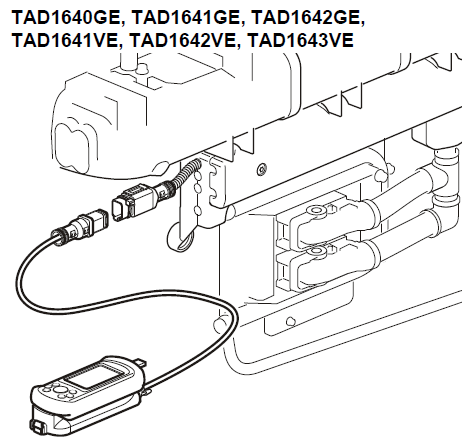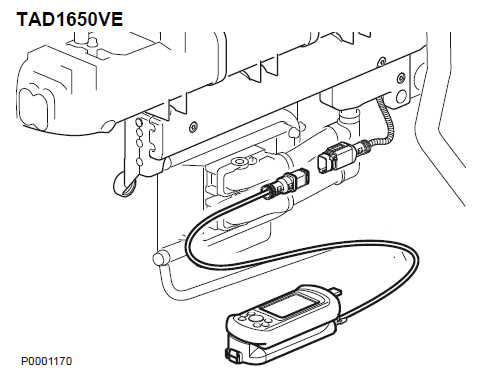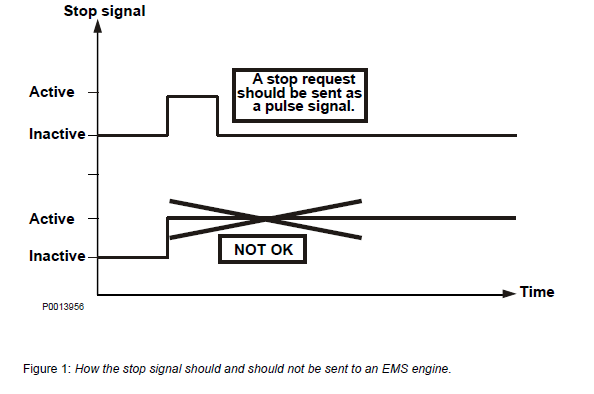Parameter Setting
Connection of special tool VODIA
Connection of special tool VODIA
TAD1640GE, TAD1641GE, TAD1642GE,
TAD1641VE, TAD1642VE, TAD1643VE


Function
It is possible to read and adjust parameters with the VODIA tool, part no.3838619, as described in the following pages.
The VODIA tool is connected to the diagnostics socket, a 6-pin connector; refer to VODIA user instructions for instructions.
Adjustable parameters
NOTICE! Some parameters require special authorization.
Inverted regulator mode
Select if droop value is to be active.
Alternative modes: “No droop value” or “Variable droop value”
Preset mode: “Fixed droop value”
Regulator mode
Select if droop value is active.
Alternative modes: “Off” or “No”
Preset mode: ”No”
Primary regulator mode
Selects the regulator to be used when the regulator contact is closed.
Alternative modes: ”Isochronous” or ”Droop value”
Preset mode: ”Isochronous”
Regulator gradient
Determines the droop value to be used (gradient)
Min. value: 10 Nm/revolution
Preset value: 25 Nm/revolution
Max. value: 128 Nm/revolution
Stop function
Preset mode: ”Stop”
CIU stop function
The CIU unit stop signal is energized during “Operations” or “Stop”.
Preset mode: ”Stop”
Lamp test
This parameter determines if a lamp test is to be performed when the system is started.
Alternative modes: “Off” or “On”
Preset mode: “On”
Idling speed
Setting idle revolutions.
Min. value: 550 rpm
Preset value: 600 rpm
Max. value: 800 rpm
TAD1650VE: 700 rpm
Idle voltage (CIU)
Throttle control input signal voltage to corresponding idle at the CIU unit.
Min. value: 0.30 V
Preset value: 1.17 V
Max. value: 1.90 V
Voltage max. rpm (CIU)
Throttle control input signal voltage to corresponding full throttle at the CIU unit.
Min. value: 1.90 V
Preset value: 4.50 V
Max. value: 4.70 V
Pre-heating for ignition
Selects if pre-heating is to be activated directly the ignition is turned on. If the parameter is in ”Off” mode, pre-heating and post heating must be activated manually via the ignition lock or pre-heater button.
Alternative modes: “Off” or “On”
Preset mode: “Off”
Alarm limits
Alarm threshold, high oil temperature
A warning lamp is lit at this temperature.
Min value: 120 °C (248 °F)
Preset value: 125 °C (257 °F)
Max value: 130 °C (266 °F)
Alarm threshold, high coolant temperature
A warning lamp is lit at this temperature.
Min value: 95 °C (203 °F)
Preset value: 98 °C (208 °F)
Max value: 107 °C (217 °F)
Engine protection
Oil temperature
Determines whether engine protection is to be activated in respect of high oil temperature. A fault code is registered and the engine is shut down.
Alternative modes: “Yes” or “No”
Preset mode: “Yes”
Coolant temperature
Determines whether Volvo engine protection is to be activated in respect of high coolant temperature. A fault code is registered and the engine is shut down.
Alternative modes: “Yes” or “No”
Preset mode: “Yes”
Coolant level
Determines whether engine protection is to be activated in respect of low coolant level. A fault code is registered and the engine is shut down.
Alternative modes: “Yes” or “No”
Preset mode: “Yes”
Charge air temperature
Determines whether engine protection is to be activated in respect of high charge air temperature. A fault code is registered and the engine is shut down.
Alternative modes: “Yes” or “No”
Preset mode: “Yes”
Charge pressure
Determines whether engine protection is to be activated in respect of high charge air pressure. A fault code is registered and the engine is shut down.
Alternative modes: “Yes” or “No”
Preset mode: “Yes”
Oil pressure
Determines whether engine protection is to be activated in respect of low oil pressure. A fault code is registered and the engine is shut down.
Alternative modes: “Yes” or “No”
Preset mode: “Yes”
Piston cooling pressure
Determines whether engine protection is to be activated in respect of low piston cooling pressure. A fault code is registered and the engine is shut down.
Alternative modes: “Yes” or “No”
Preset mode: “Yes”
Crankcase pressure
Determines whether engine protection is to be activated in respect of high crankcase pressure. A fault code is registered and the engine is shut down.
Alternative modes: “Yes” or “No”
Preset mode: “Yes”
Overspeed warning shutdown
Determines whether engine protection is to be activated in respect of overspeed. A fault code is registered and the engine is shut down.
Alternative modes: “Yes” or “No”
Preset mode: “Yes”
Exhaust temperature (only TWD1643GE)
Determines whether engine protection is to be activated in respect of high exhaust temperature. A fault code is registered and the engine is shut down.
Alternative modes: “Yes” or “No”
Preset mode: “Yes”
CAN bus settings
Background
With new emission legislations the requirements on customer panels increases and a document describing what needs to be implemented in the OEM CAN panels is needed.
Requirements on OEM panels
There is one message that has to be sent to the VP EECU and that is the VP status message. See section VP STATUS MESSAGE: OC FF 46 11. Without this message the EECU will set a fault code on the CAN bus and disregard more communication.
Engine interface connector (EIC)
The EIC contains 8 pins with the following functions:
1 CAN High
2 CAN Low
3 Battery minus
4 Battery plus
5 Ignition and energized to run extra stop
6 Energized to extra stop
7 J1587A
8 J1587B
This is where any CAN panel shall connect to battery plus and battery minus in order to be powered. Battery after key and extra stop shall get the positive voltage from pin 4 (battery plus) when powered.
Battery after key - signal
The battery after key - signal is a “wake up” signal to the EMS. When this pin get powered the main relay will be activated which will power the EMS and the EMS will start to communicate.
This pin should have power for as long as the EMS is supposed to communicate. The EMS will hold this relay even without getting power via this signal once the software is up and running. However, in order to avoid problems in the aftermarket, it shall always be power on this pin when the EMS is supposed to communicate.
NOTICE! The battery after key signal can be configured via VP aftermarket tool. So that the engine will stop if power is removed from the pin. (Pin 5 in the 8- pole Engine Interface Connector; EIC). It shall also always be possible to power this pin without having to start the engine in order to be able to work on the engine with after market tools.
Extra stop - signal
The stop input signal, stops the engine when voltage is applied to this pin. (Pin 6 in the 8-pole Engine Interface Connector; EIC)
Never have a stop signal being continuously sent to a powered control unit. If there is a continuous active stop signal over time, it could damage the engine control unit. Figure 1 shows that the stop signal should be sent as a pulse signal.

The voltage to the stop signal should come from pin 4 in the engine interface connector.
Copyright © Guangxi Dingbo Generator Set Manufacturing Co., Ltd. All Rights Reserved | Sitemap
Update cookies preferences